Investigation of Tensile Properties and In Situ Analysis of Fracture Behavior in High-Porosity Open-Cell Nickel Foam
Abstract
1. Introduction
2. Materials and Methods
3. Results and Discussion
3.1. Influence of Relative Density on Tensile Properties of Nickel Foam
3.2. Anisotropy of Nickel Foams’ Tensile Properties
3.3. Fracture Process Analysis Through In Situ OM and SEM
3.4. Discussion
4. Conclusions
Supplementary Materials
Author Contributions
Funding
Institutional Review Board Statement
Informed Consent Statement
Data Availability Statement
Conflicts of Interest
References
- Zhao, B.; Gain, A.K.; Ding, W.; Zhang, L.; Li, X.; Fu, Y. A review on metallic porous materials: Pore formation, mechanical properties, and their applications. Int. J. Adv. Manuf. Technol. 2018, 95, 2641–2659. [Google Scholar] [CrossRef]
- Patel, P.; Bhingole, P.; Makwana, D. Manufacturing, characterization and applications of lightweight metallic foams for structural applications. Mater. Today Proc. 2018, 5, 20391–20402. [Google Scholar] [CrossRef]
- Tomin, M.; Kmetty, Á. Polymer foams as advanced energy absorbing materials for sports applications—A review. J. Appl. Polym. Sci. 2022, 139, 51714. [Google Scholar] [CrossRef]
- Shajari, Y.; Nikzad, L.; Razavi, M. Investigation on mechanical properties of nickel open cell metal foam after heat treatment. Sci. Rep. 2023, 13, 16569. [Google Scholar] [CrossRef] [PubMed]
- Vesenjak, M.; Fiedler, T.; Ren, Z.; Öchsner, A. Behaviour of syntactic and partial hollow sphere structures under dynamic loading. Adv. Eng. Mater. 2008, 10, 185–191. [Google Scholar] [CrossRef]
- Kemény, A.; Movahedi, N.; Fiedler, T.; Maróti, J.E.; Orbulov, I.N. The influence of infiltration casting technique on properties of metal syntactic foams and their foam-filled tube structures. Mater. Sci. Eng. A 2022, 852, 143706. [Google Scholar] [CrossRef]
- Vesenjak, M.; Veyhl, C.; Fiedler, T. Analysis of anisotropy and strain rate sensitivity of open-cell metal foam. Mater. Sci. Eng. A 2012, 541, 105–109. [Google Scholar] [CrossRef]
- Aghion, E.; Perez, Y. Effects of porosity on corrosion resistance of Mg alloy foam produced by powder metallurgy technology. Mater. Charact. 2014, 96, 78–83. [Google Scholar] [CrossRef]
- Almonti, D.; Baiocco, G.; Mingione, E.; Ucciardello, N. Evaluation of the effects of the metal foams geometrical features on thermal and fluid-dynamical behavior in forced convection. Int. J. Adv. Manuf. Technol. 2020, 111, 1157–1172. [Google Scholar] [CrossRef]
- Arévalo-Cid, P.; Vaz, M.; Montemor, M. Highly porous FeNi 3D foams produced by one-step electrodeposition: Electrochemical stability and mechanical properties. Mater. Charact. 2022, 193, 112311. [Google Scholar] [CrossRef]
- Ashby, M. Metal Foams: A Design Guide; Butterworth-Heinemann College: Oxford, UK, 2000. [Google Scholar]
- Wang, Y.; Zhang, W.; Qi, Y.; Wang, S.; Liu, P.; Wei, X.; Yu, Y.; Sun, W.; Zhao, X.-Z.; Liu, Y. Uniform titanium nitride decorated Cu foams by electrophoretic deposition for stable lithium metal anodes. J. Alloys Compd. 2021, 874, 159916. [Google Scholar] [CrossRef]
- Quadbeck, P.; Kümmel, K.; Hauser, R.; Standke, G.; Adler, J.; Stephani, G. Open cell metal foams-application-oriented structure and material selection. Proc. CELLMAT 2010, 238–279. [Google Scholar]
- Shi, Z.; Szpunar, J.A. The introduction of thin open-cell metal foams and their wider engineering applications. Mater. Sci. Forum 2018, 933, 112–122. [Google Scholar] [CrossRef]
- Bernard, P.; Lippert, M. Nickel–cadmium and nickel–metal hydride battery energy storage. In Electrochemical Energy Storage for Renewable Sources and Grid Balancing; Elsevier: Amsterdam, The Netherlands, 2015; pp. 223–251. [Google Scholar]
- Metzger, W.; Westfall, R.; Hermann, A.; Lyman, P. Nickel foam substrate for nickel metal hydride electrodes and lightweight honeycomb structures. Int. J. Hydrogen Energy 1998, 23, 1025–1029. [Google Scholar] [CrossRef]
- Li, Y.; Xia, X.-L.; Sun, C.; Ai, Q.; Liu, B.; Tan, H.-P. Tomography-based analysis of apparent directional spectral emissivity of high-porosity nickel foams. Int. J. Heat Mass Transf. 2018, 118, 402–415. [Google Scholar] [CrossRef]
- Yuan, Y.; Xia, X.; Wu, J.; Yang, J.; Chen, Y.; Guo, S. Nickel foam-supported porous Ni (OH) 2/NiOOH composite film as advanced pseudocapacitor material. Electrochim. Acta 2011, 56, 2627–2632. [Google Scholar] [CrossRef]
- Kumar, K.D.; Ramachandran, T.; Kumar, Y.A.; Mohammed, A.A.; Kang, M. Hierarchically fabricated nano flakes-rod-like CoMoO–S supported Ni-foam for high-performance supercapacitor electrode material. J. Phys. Chem. Solids 2024, 185, 111735. [Google Scholar] [CrossRef]
- Aly, M.S. Tensile properties of open-cell nickel foams. Mater. Des. 2010, 31, 2237–2240. [Google Scholar] [CrossRef]
- Badiche, X.; Forest, S.; Guibert, T.; Bienvenu, Y.; Bartout, J.-D.; Ienny, P.; Croset, M.; Bernet, H. Mechanical properties and non-homogeneous deformation of open-cell nickel foams: Application of the mechanics of cellular solids and of porous materials. Mater. Sci. Eng. A 2000, 289, 276–288. [Google Scholar] [CrossRef]
- Bedarf, P.; Dutto, A.; Zanini, M.; Dillenburger, B. Foam 3D printing for construction: A review of applications, materials, and processes. Autom. Constr. 2021, 130, 103861. [Google Scholar] [CrossRef]
- Burteau, A.; Bartout, J.-D.; Bienvenu, Y.; Forest, S. On the creep deformation of nickel foams under compression. Comptes Rendus Phys. 2014, 15, 705–718. [Google Scholar] [CrossRef]
- Ramamurty, U.; Paul, A. Variability in mechanical properties of a metal foam. Acta Mater. 2004, 52, 869–876. [Google Scholar] [CrossRef]
- Papadopoulos, D.; Konstantinidis, I.C.; Papanastasiou, N.; Skolianos, S.; Lefakis, H.; Tsipas, D. Mechanical properties of Al metal foams. Mater. Lett. 2004, 58, 2574–2578. [Google Scholar] [CrossRef]
- Rabiei, A.; O’Neill, A.T. A study on processing of a composite metal foam via casting. Mater. Sci. Eng. A 2005, 404, 159–164. [Google Scholar] [CrossRef]
- Benouali, A.-H.; Froyen, L.; Delerue, J.; Wevers, M. Mechanical analysis and microstructural characterisation of metal foams. Mater. Sci. Technol. 2002, 18, 489–494. [Google Scholar] [CrossRef]
- Fan, S.-f.; Zhang, T.; Kun, Y.; Fang, H.-j.; Xiong, H.-q.; Dai, Y.-l.; Jiang, D.-y.; Zhu, H.-l. Compressive properties and energy absorption characteristics of open-cell nickel foams. Trans. Nonferrous Met. Soc. China 2017, 27, 117–124. [Google Scholar] [CrossRef]
- Fesahat, M.; Vafaeenezhad, H.; Esnaashary, M.; Yazdi, A.; Hosseinabadi, F.; Soltanieh, M. A micromechanical approach to deformation and damage of nickel foam used in conductive layer of lithium-ion battery. Mater. Sci. Eng. A 2021, 825, 141895. [Google Scholar] [CrossRef]
- Su, L.; Zhan, J.; Gu, Q.; Chen, H.; Wang, L.; Wang, Y.; Hu, Q.; Ren, M. N-doped carbon nanolayer modified nickel foam: A novel substrate for supercapacitors. Appl. Surf. Sci. 2021, 546, 148754. [Google Scholar] [CrossRef]
- Ashby, M.F.; Medalist, R.M. The Mechanical Properties of Cellular Solids; Springer: Berlin/Heidelberg, Germany, 1983. [Google Scholar]
- Maiti, S.; Ashby, M.; Gibson, L. Fracture toughness of brittle cellular solids. Scr. Metall. 1984, 18, 213–217. [Google Scholar] [CrossRef]
- Gibson, L.; Ashby, M.; Zhang, J.; Triantafillou, T. Failure surfaces for cellular materials under multiaxial loads—I. Modelling. Int. J. Mech. Sci. 1989, 31, 635–663. [Google Scholar] [CrossRef]
- Mahabunphachai, S.; Koç, M.; Ni, J. Pressure welding of thin sheet metals: Experimental investigations and analytical modeling. J. Manuf. Sci. Eng. 2009, 131, 041003. [Google Scholar] [CrossRef]
- Liu, P.; Fu, C.; Li, T.; Shi, C. Relationship between tensile strength and porosity for high porosity metals. Sci. China Ser. E Technol. Sci. 1999, 42, 100–107. [Google Scholar] [CrossRef]
- Liu, P. The tensile strength of porous metals with high porosity. J. Adv. Mater. 2000, 32, 9–16. [Google Scholar]
- Miranda, G.; Carvalho, O.; Soares, D.; Silva, F. Properties assessment of nickel particulate-reinforced aluminum composites produced by hot pressing. J. Compos. Mater. 2016, 50, 523–531. [Google Scholar] [CrossRef]
- Qiu, P.; Wu, G.-h.; Sun, D.-l.; Xiu, Z.-y.; Zhang, Q.; Hu, Z.-l. Compressive property and energy absorption characteristic of 3D open-cell Ni–Cr–Fe alloy foams under quasi-static conditions. Trans. Nonferrous Met. Soc. China 2012, 22, s566–s572. [Google Scholar]
- Liu, P.; Liang, K.; Tu, S.; Gu, S.; Yu, Q.; Li, T.; Fu, C. Relationship between tensile strength and preparation conditions for nickel foam. Mater. Sci. Technol. 2001, 17, 1069–1072. [Google Scholar] [CrossRef]
- Lee, K.; Lewandowski, J. Effects of microstructural characteristics on mechanical properties of open-cell nickel foams. Mater. Sci. Technol. 2005, 21, 1355–1358. [Google Scholar] [CrossRef]
- Ochiai, S.; Nakano, S.; Fukazawa, Y.; Aly, M.S.; Okuda, H.; Kato, K.; Isobe, T.; Kita, K.; Honma, K. Tensile deformation and failure behavior of open cell nickel and copper foams. Mater. Trans. 2010, 51, 699–706. [Google Scholar] [CrossRef]
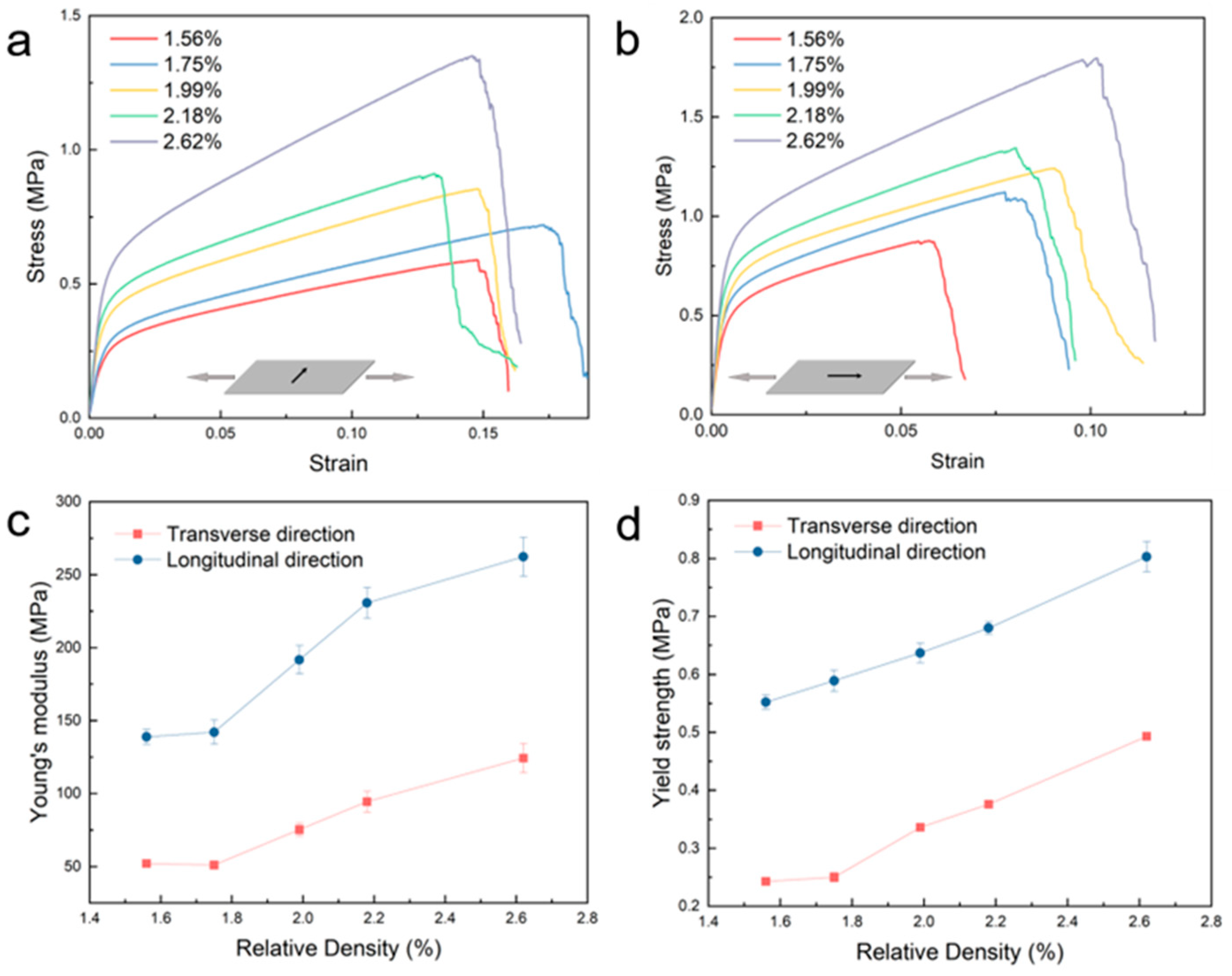
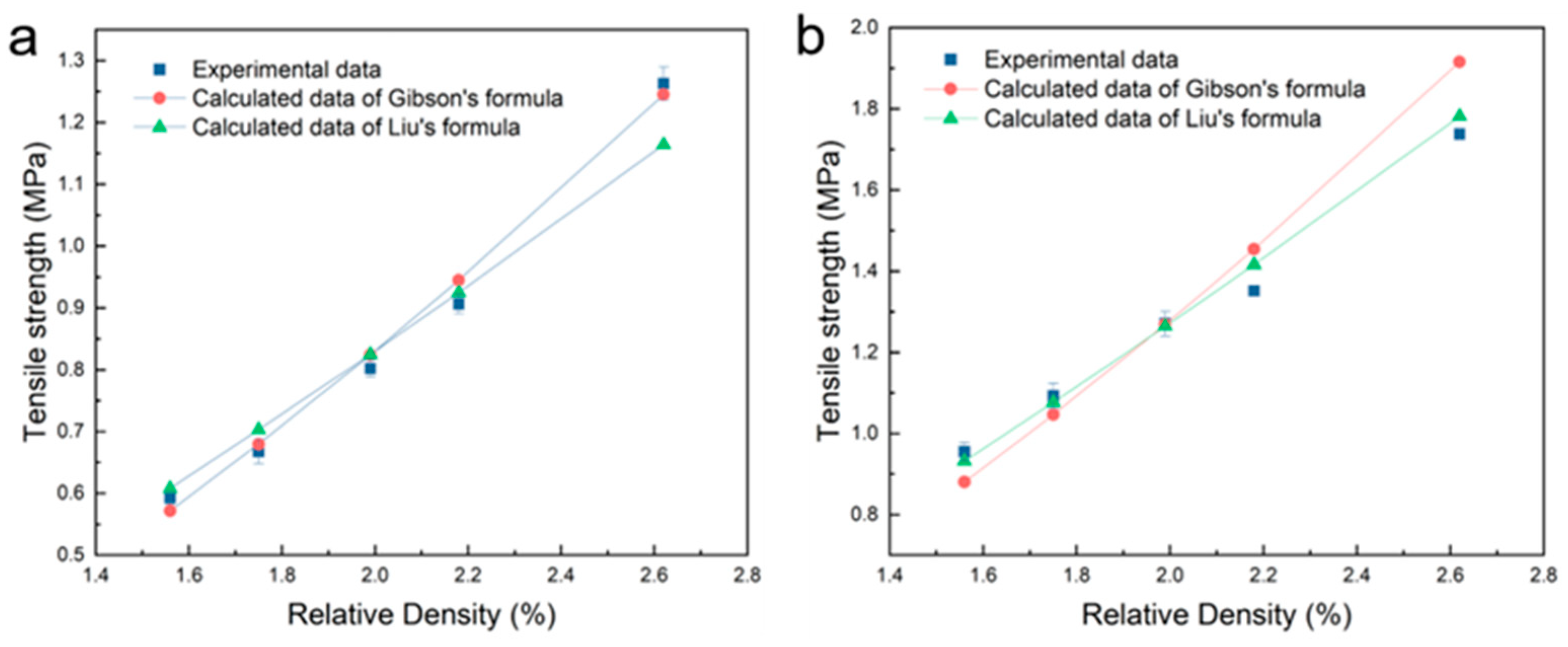
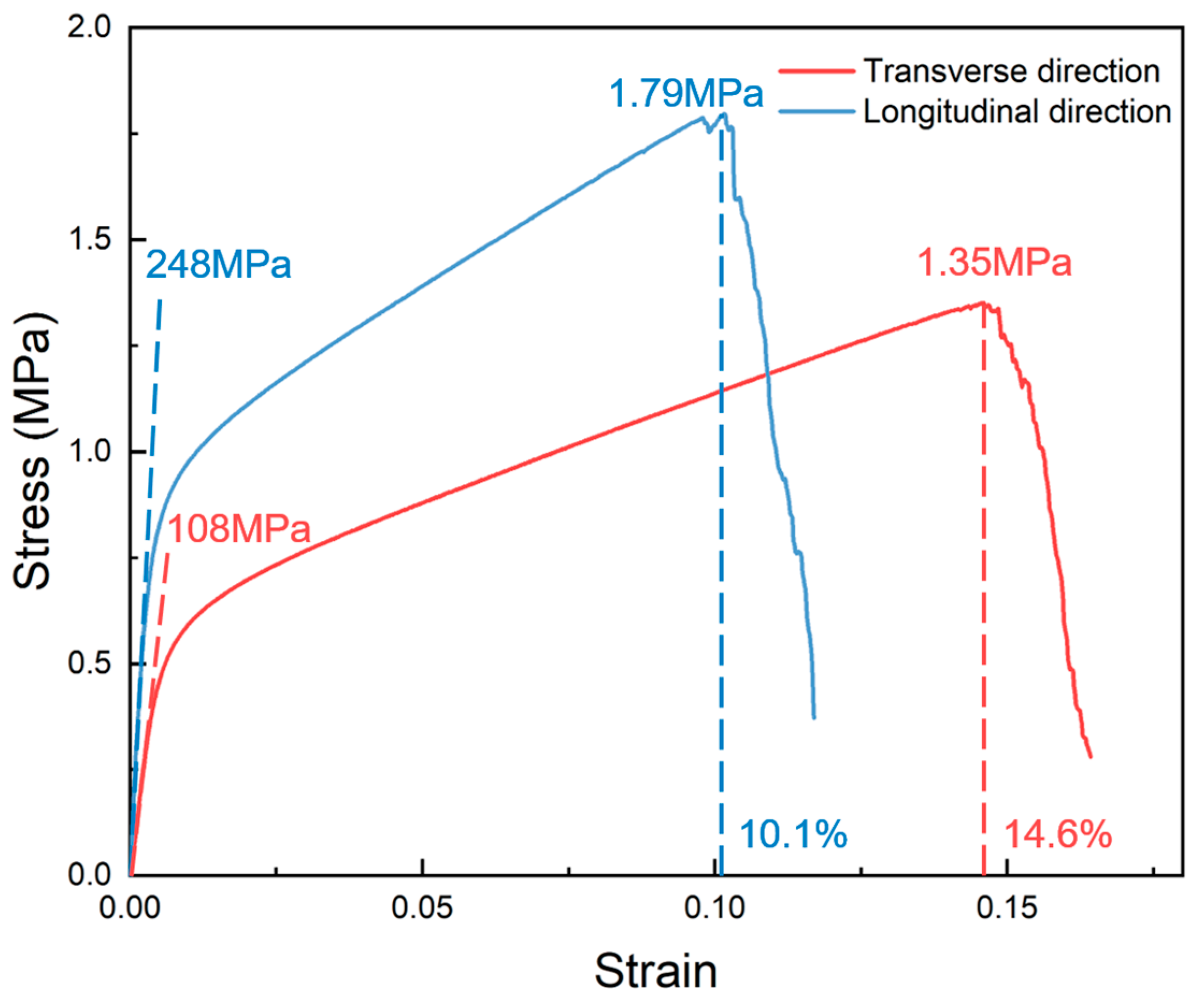
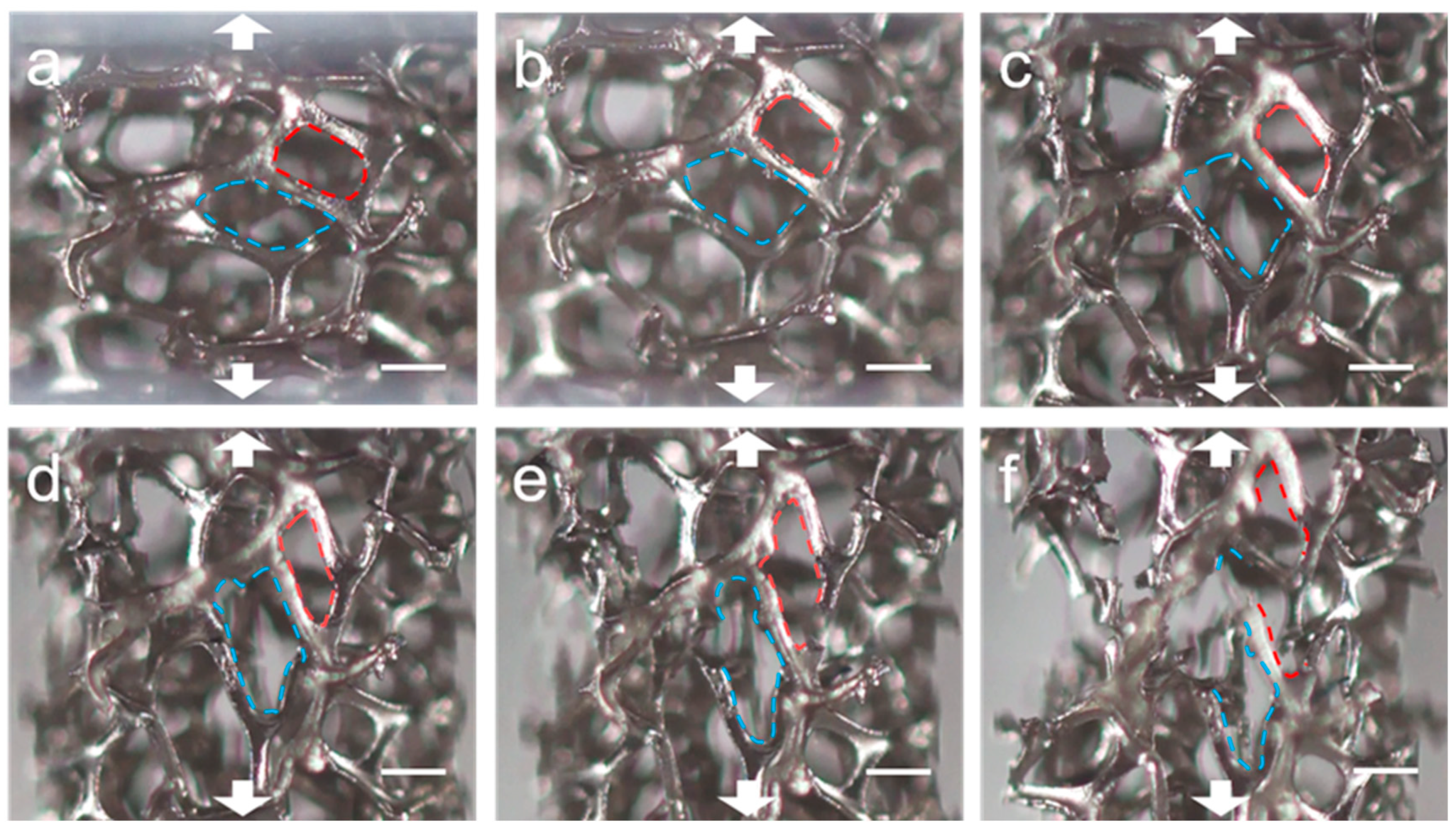
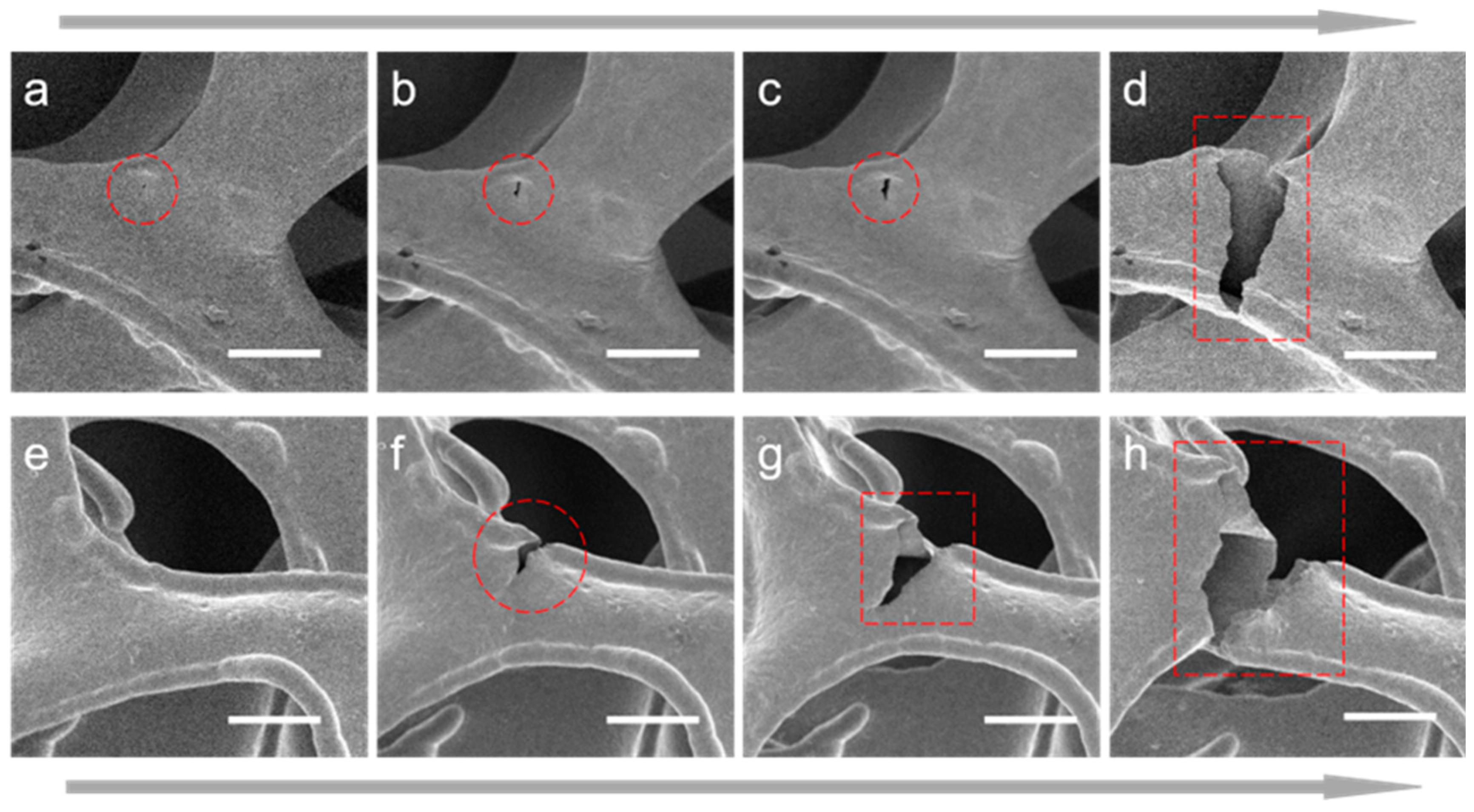
Disclaimer/Publisher’s Note: The statements, opinions and data contained in all publications are solely those of the individual author(s) and contributor(s) and not of MDPI and/or the editor(s). MDPI and/or the editor(s) disclaim responsibility for any injury to people or property resulting from any ideas, methods, instructions or products referred to in the content. |
© 2024 by the authors. Licensee MDPI, Basel, Switzerland. This article is an open access article distributed under the terms and conditions of the Creative Commons Attribution (CC BY) license (https://creativecommons.org/licenses/by/4.0/).
Share and Cite
Fan, S.; Wang, X.; Kong, Z.; Hou, Q. Investigation of Tensile Properties and In Situ Analysis of Fracture Behavior in High-Porosity Open-Cell Nickel Foam. Materials 2024, 17, 5223. https://doi.org/10.3390/ma17215223
Fan S, Wang X, Kong Z, Hou Q. Investigation of Tensile Properties and In Situ Analysis of Fracture Behavior in High-Porosity Open-Cell Nickel Foam. Materials. 2024; 17(21):5223. https://doi.org/10.3390/ma17215223
Chicago/Turabian StyleFan, Sufeng, Xihai Wang, Zhe Kong, and Qinghua Hou. 2024. "Investigation of Tensile Properties and In Situ Analysis of Fracture Behavior in High-Porosity Open-Cell Nickel Foam" Materials 17, no. 21: 5223. https://doi.org/10.3390/ma17215223
APA StyleFan, S., Wang, X., Kong, Z., & Hou, Q. (2024). Investigation of Tensile Properties and In Situ Analysis of Fracture Behavior in High-Porosity Open-Cell Nickel Foam. Materials, 17(21), 5223. https://doi.org/10.3390/ma17215223



